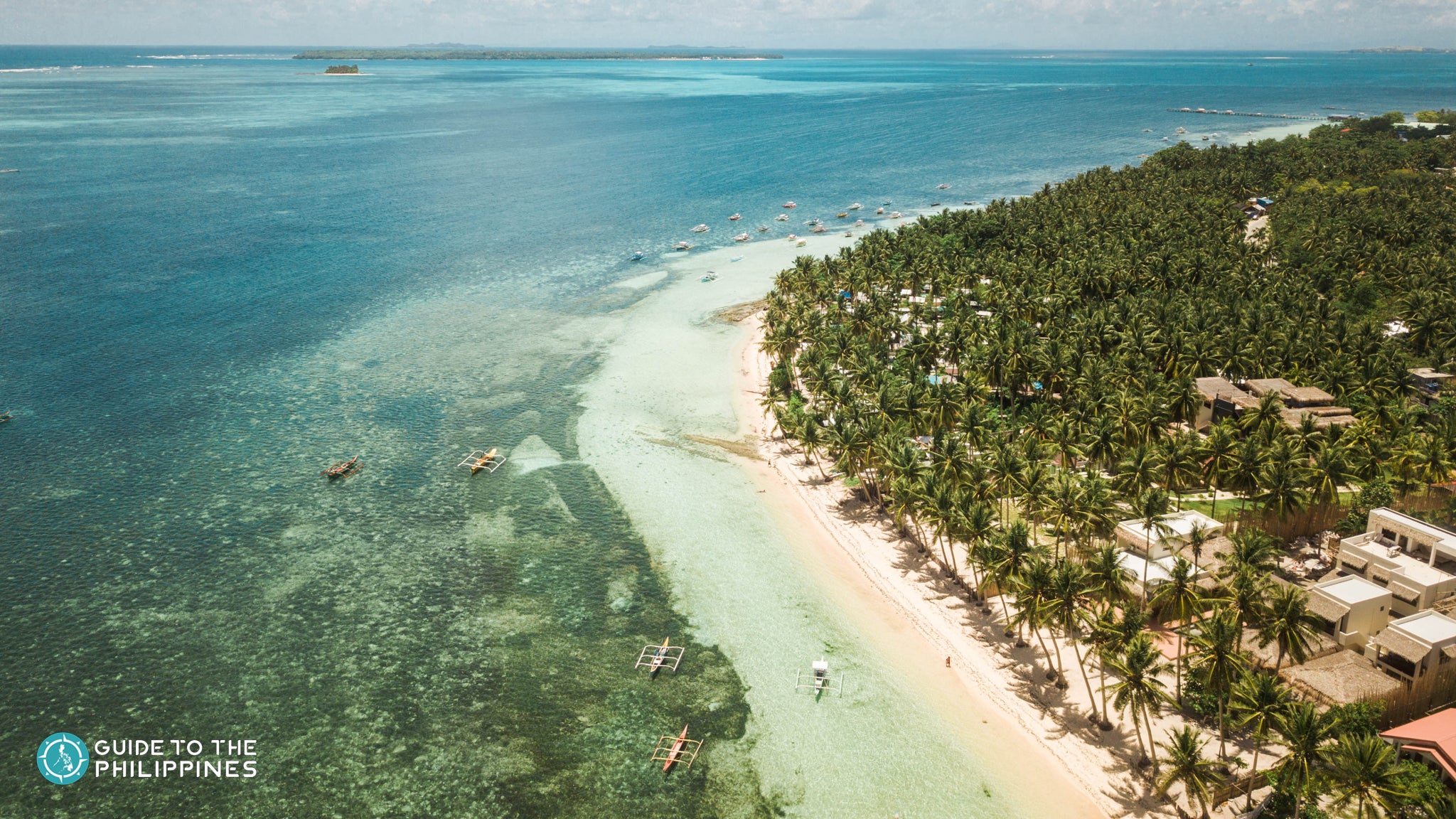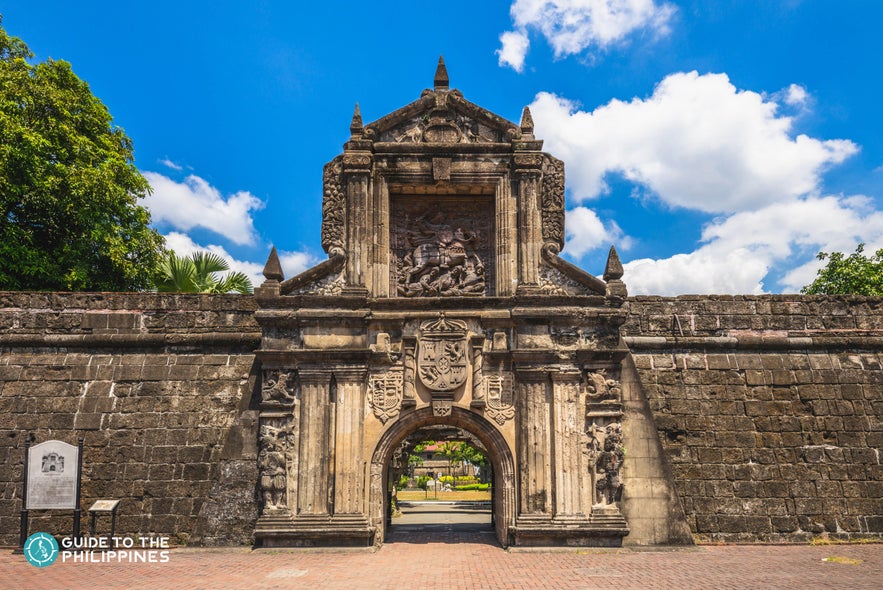
Intramuros Old Town, Manila City’s historic walled district, invites you to step back in time and explore the Philippines' rich past. Established over 400 years ago by Spanish colonizers, it served as their political and military stronghold in Asia. Today, Intramuros Old Town is one of the best places to visit in Manila City, offering visitors a glimpse into the country's storied history through its preserved architecture and cultural landmarks.
"Intramuros" literally means "within the walls," referring to the impressive 4.5-kilometer fortifications that once protected the city from invaders. These ancient walls, complete with moats, cannons, and bulwarks, still surround much of the area, creating a distinct atmosphere where history comes alive.
Find out which buildings, churches, plazas, museums, and tours in Intramuros Old Town offer the best history lessons about the Spanish colonial era in the capital city of the Philippines. Read this travel guide to help you plan your visit and discover the best things to do in Intramuros Old Town, from exploring historic landmarks to enjoying cultural experiences within Manila City's iconic walled district.
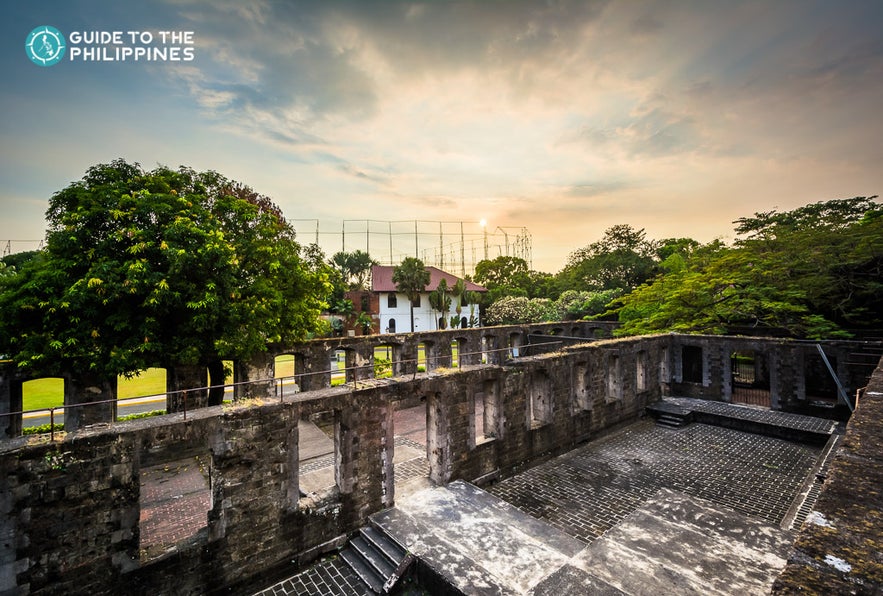
Exploring Intramuros Old Town feels like stepping back in time. Wander along the ancient walls, explore captivating museums, and enjoy cultural performances that bring history vividly to life. Whether you choose a walking tour, a traditional horse-drawn carriage ride, or a bike tour around Intramuros Old Town, this historic walled district offers an immersive and memorable experience in the heart of Manila City.
Inside the walls of Intramuros Old Town, cobblestone streets guide you to magnificent baroque churches, colonial-era buildings, and scenic plazas. Must-visit spots include Fort Santiago, a centuries-old citadel brimming with historical stories; the majestic Manila Cathedral; and the beautifully intricate San Agustin Church, a UNESCO World Heritage site. The remaining ruins, remnants of past battles, only add to the nostalgic charm of this historic district.
- Discover the widest selection of tours to Manila City attractions for more unforgettable experiences in the capital city of the Philippines
This friendly guide will help you plan what to do in Intramuros Old Town, offering tips on the best times to visit, top attractions, and helpful advice to ensure your historical adventure is seamless and memorable.
Key Takeaways
-
Intramuros is the historic walled city of Manila, built during the Spanish colonial period and considered the heart of the country’s cultural and political life for over 300 years.
-
Top attractions in Intramuros old town include Fort Santiago, San Agustin Church (a UNESCO World Heritage Site), and the Manila Cathedral, all showcasing Spanish-era architecture and Philippine history.
-
Intramuros old town offers immersive cultural experiences, including museums like Casa Manila, the Rizal Shrine, and guided walking or bamboo bike tours that bring its history to life.
-
The area is also home to charming cobblestone streets, horse-drawn carriage (kalesa) rides, and quaint cafés, making it a scenic destination for photography and relaxed strolls.
-
Visitors can explore churches, plazas, and colonial-era ruins, gaining insight into the country’s struggles during colonization, the Japanese occupation, and World War II.
-
The walled city of Intramuros is easily accessible from other parts of Metro Manila region and is often included as a stop in Manila City tours or historical sightseeing packages.
-
The best time to visit Intramuros old town is during the dry season, from December to May, for comfortable walks and clear views of its historical landmarks.
-
Cruise passengers docked in the capital city can join Intramuros tours from the Manila cruise port, with options for independent tours that include top landmarks, cultural stops, and walking experiences. These are ideal for travelers looking for memorable things to do in Intramuros for cruise passengers.
-
You can book tours in Intramuros old town and Manila City tour packages through Guide to the Philippines to enjoy a convenient and informative exploration of this iconic district.
Best Time to Go to Intramuros Old Town

Your perfect Intramuros Old Town itinerary begins with choosing the best time to visit. With its fascinating history and picturesque streets, Intramuros Old Town is a destination you can enjoy year-round. However, the weather and crowd conditions can greatly impact your experience. Whether you're wandering through historical landmarks, cycling along the ancient walls, or soaking in the lively atmosphere, knowing the best time to visit ensures you get the most out of your adventure.
Here’s a guide to the ideal months to explore Intramuros Old Town and what you can expect during each season.
Dry Season | December to May
The dry season in the Philippines is divided into the cool dry and hot dry periods, both ideal for exploring Intramuros Old Town without the risk of rain. December to February offers pleasant weather with cooler temperatures, making it comfortable for long walks.
However, temperatures can soar above 33°C from March to May, making the city extremely hot. If you plan to visit during these months, it's best to schedule your excursions in the early morning or late afternoon to avoid the intense midday heat.
Holiday Season | September to December
Filipinos are known for their love of Christmas, with decorations and festive music appearing as early as September—also known as the start of the "ber" months. This period offers a delightful holiday atmosphere with cooler weather, making it a wonderful time to explore Intramuros Old Town.
However, be prepared for heavy traffic even outside peak hours due to the holiday rush. Additionally, September to November remains part of the rainy season, so it's wise to check the weather forecast and bring a rain jacket or umbrella just in case.
-
Check out the complete list of holidays and long weekends in the Philippines
Climate and Weather
The Philippines has two primary seasons: rainy and dry.
-
Rainy Season (June to November): This period often sees heavy rainfall and typhoons, which may disrupt outdoor plans.
-
Dry Season (December to May): Divided into:
-
Cool Dry (December to February): Fewer rains and comfortable temperatures.
-
Hot Dry (March to May): Typically called summer, with high temperatures and little to no rainfall. During hot dry months, the daily temperature can go above 33°C.
-
Plan your visit during the cooler months of the dry season for a more comfortable and enjoyable experience in Intramuros Old Town.
What to Wear

Photo by the Philippine Department of Tourism
If you're visiting during the cool dry months or holidays, comfortable sneakers or sandals are ideal for exploring the cobblestone streets. Carrying an umbrella is a good idea, especially if light showers are expected. When planning what to pack for the Philippines, don’t forget to bring a jacket or raincoat for cooler evenings or occasional rain, as it’s always wise to be prepared for changes in weather.
For those visiting during the hot dry months, light, breathable clothing is a must, particularly if you're planning a walking tour. Be prepared for the heat—bring a handkerchief, an umbrella, and a change of clothes to stay comfortable. Most importantly, stay hydrated and carry a bottle of water to keep refreshed throughout your adventure.
How to Go to Intramuros Old Town

Intramuros Old Town, located in the heart of bustling Manila City, is easily accessible from major airports in the Philippines, making it convenient for travelers coming from outside Metro Manila or abroad. Whether you're landing at Ninoy Aquino International Airport (NAIA) or Clark International Airport, you’ll have no trouble reaching this historic gem.
For the quickest access to Intramuros Old Town, opt for flights to the Philippines that land at either NAIA or Clark Airport. NAIA is the closest option, situated in Metro Manila, while Clark International Airport, located in Pampanga province, also serves as a key gateway for both domestic and international flights.
Once you arrive in the Philippines, you have several options to reach Intramuros Old Town. You can take a private car for a convenient and direct route, hop on a train for an affordable and quick option, or catch a bus for a budget-friendly ride. Alternatively, you can use a car-hailing app to easily book a ride. Each of these options provides flexibility depending on your preferences and budget.
By Private Car
For the ultimate convenience, booking Manila airport transfers ahead of your trip guarantees a smooth, hassle-free journey directly to Intramuros Old Town or your hotel in Manila City as soon as you arrive at the airport. This option is perfect for those who want a seamless experience from the moment they land, without worrying about transportation.
If you prefer more independence, you can also avail of car rentals in Manila City. You can book a car in advance or easily arrange one upon arrival at NAIA Terminals 1, 2, or 3. Just be sure to have the necessary documents for renting a car in the Philippines. Keep in mind, however, that driving in Manila City can be challenging due to the traffic, so it’s best to be prepared with patience and local driving skills.
By Taxi
Another convenient way to reach Intramuros Old Town is by hailing a taxi. Taxis in Manila City operate with a flag-down rate plus a distance-based fare. While fares may initially seem affordable, be aware that heavy traffic in Metro Manila can result in a higher fare than expected.
Additionally, it's important to be cautious of potential taxi scams, such as drivers claiming their meters are "broken" and offering flat rates instead. Always ask the driver to turn on the meter before you start your ride. If the driver hesitates or insists on a fixed fare, it's best to find another taxi.
If you prefer a direct and hassle-free journey without the need to switch between transport modes or walk long distances, taking a taxi remains a great choice for convenience—just be sure to stay vigilant.
From NAIA or Other Cities in and Around Metro Manila
At NAIA, you’ll encounter three types of taxis: regular (white, metered cabs with fixed flag-down and per-kilometer rates), coupon (blue-marked white taxis dispatched by airport personnel with a fixed price), and yellow airport taxis (metered, but with flag-down and per-kilometer fees that are twice the cost of regular taxis).
Be cautious and always ask about the fare or confirm the details before getting into any taxi at the airport.
From Clark Airport and Nearby Provinces
Taking a taxi from Clark Airport to Intramuros Old Town is not recommended due to the high fare and the difficulty of finding a driver willing to travel that distance. Your best bet is to take a bus—different bus lines have terminals and stops around Metro Manila where you can get off, with the closest ones in Manila itself and Pasay City.
By Train

The three main train lines running in Metro Manila can take you near Intramuros: Light Rail Transit (LRT) 1 and 2, and the Manila Metro Rail Transit (MRT).
Travelers coming from nearby cities or provinces can easily transfer between stations to reach Intramuros Old Town, as all three lines are interconnected. MRT and LRT1 connect at Baclaran and North Avenue stations, MRT and LRT2 meet at Araneta-Cubao, and LRT1 and LRT2 are connected at Doroteo Jose.
The closest station to Intramuros Old Town is the LRT1 Central Terminal Station. While it is the nearest, you will need to walk quite a bit to reach the eastern side of Intramuros. Many travelers prefer to hail a cab from here for convenience.
If you decide to walk, head towards Manila City Hall, then take the pedestrian underpass to cross over to Padre de Burgos Street. Upon exiting, you'll find Victoria Street, which will lead you directly into Intramuros. From there, you'll still need to walk to reach the western side, where many of the sights are located.
By Bus
Buses are a convenient option for reaching Intramuros Old Town if you're coming from farther locations, though there are also bus lines that loop around Metro Manila.
Keep in mind that no public transportation stops directly in front of the gates of Intramuros Old Town, so you’ll need to walk from the closest unloading areas.
From NAIA
You can take the Airport Loop buses from any of the NAIA terminals. Stops include Baclaran, Pasay Rotonda, and Taft Avenue stations of the LRT and MRT. From these stations, you can ride the LRT line and get off at the Central Station, which is closer to Intramuros Old Town.
From Clark and Other Neighboring Provinces
Bus lines from nearby provinces stop or pass through Manila. While many of these buses don’t have stops directly near Intramuros Old Town, you can easily take a cab or jeep, or get off at the nearest LRT station to reach Intramuros.
By Car Booking App
An excellent alternative to hailing a cab is to book a car through the ride-hailing app Grab. Grab Philippines also offers both GrabTaxi (a regular metered taxi) and GrabShare (a carpooling option).
Metro Manila has a high saturation of Grab cars, so you’re likely to secure a ride if you’re already in the area and heading to Intramuros Old Town. However, be prepared for potential difficulty booking during peak hours.
Unfortunately, Grab cars are not as readily available in more rural areas. While other ride-hailing apps such as InDrive, Owto, and MiCab exist, they are not as widely used as Grab.
Getting Around Intramuros Old Town
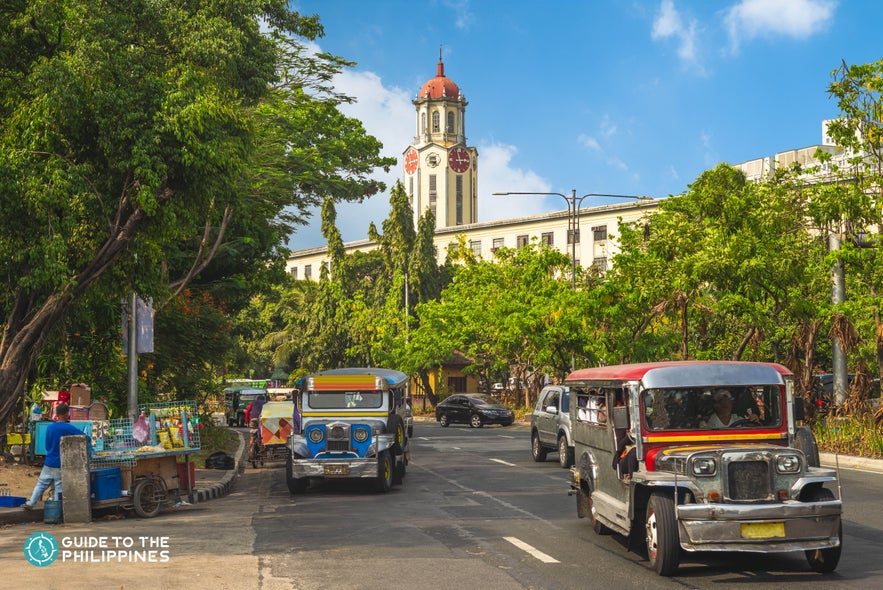
Now that you know how to go to Intramuros Old Town, let’s dive into how you can explore the area. Despite its relatively small land area (approximately 67 hectares), navigating the entire Intramuros Old Town in a single day on foot can be exhausting.
While you can certainly walk between sights that are 10 to 15 minutes apart, covering the entirety of Intramuros Old Town in one day, especially under the heat, can be quite a challenge.
Luckily, various public transport options are available within the walled city, allowing you to move easily from one point to another—or even offering you a glimpse of the past or a peek into the future.
Pedicabs
Pedicabs in Intramuros Old Town are a unique and fun way to get around. These vehicles are similar to tricycles but with a bicycle instead of a motorcycle, and they resemble rickshaws with a side compartment attached to the bike. Like tricycles, pedicabs are ideal for navigating the narrower, inner roads of Intramuros.
Pedicab terminals can be found throughout Intramuros, and if there’s a line, you can simply wait your turn. Alternatively, if you spot an available pedicab while strolling, feel free to hail it. Keep in mind that these pedicabs have a small seating capacity, usually only enough for two small people.
If you’re looking to explore more of Intramuros Old Town, you can also hire a pedicab for a full tour. Pedicab drivers are knowledgeable about the area and can guide you to all the must-see sights within the historic district.
Kalesa

Horse-drawn carriages, or kalesa, were once common in the 18th century. While not the most efficient mode of transport today, they now serve primarily for tourism.
Riding a kalesa offers a leisurely, old-fashioned way to explore Intramuros Old Town. Similar to pedicabs, the coachman can guide you to the sights during a kalesa tour. Kalesas can accommodate 1–3 passengers.
E-trike
If the kalesa ride transports you to the golden years of the humble carriage, then a ride in the modern electric tricycle, or e-trike, will quickly bring you back to the present day. The three-wheeled electric vehicles (EV) were launched in 2016 and stop at 13 spots with the trip spanning around 25 minutes.
The stops are as follows: Round Table, Pamantasan ng Lungsod ng Maynila, San Diego Gardens, the office of the Department of Labor and Employment, San Agustin Church, Manila Cathedral, Plaza Roma, Lyceum of the Philippines University, Mapua University, Manila High School, Colegio de San Juan de Letran, National Press Club, and the office of Bureau of Immigration.
Aside from regular trips, the EVs can also be chartered for a tour around the historical landmarks of Intramuros.
Tickets can be bought at booths located near Manila Cathedral, Casa Manila, Round Table, Manila HS, Lyceum, and Bureau of Internal Revenue office.
Bamboo Bike

Photo by Travels With A Hobo
Roam through the historic streets of Intramuros Old Town in an eco-friendly and unique way with a bamboo bike tour. Offered by Bambike Ecotours, this bamboo bike tour around Intramuros Old Town combines the thrill of cycling with the charm of exploring one of Manila City's most iconic areas.
The bikes used in the tour are handcrafted by the “Bambuilders” of Gawad Kalinga, a community development organization that empowers local communities. Not only will you enjoy the beauty and history of Intramuros, but you’ll also support a great cause. The tour provides an educational experience as you visit key landmarks, learning about Manila City's rich cultural heritage while enjoying the scenic views of the walled city.
On foot
If you’re up for the challenge, grab an Intramuros map and explore on foot, hopping from one attraction to another. While walking offers an intimate experience, you’ll need to be prepared for unpredictable weather and the occasional need to share the road with passing cars. Some streets lack proper pavements, so it's important to stay alert as you navigate through the historic area.
Where to Stay in Intramuros Old Town

Photo by Bayleaf Hotel Intramuros
When planning your stay in Intramuros Old Town, you'll find that options within the walled city are limited due to the area’s small size. These accommodations can sometimes be on the pricier side, but there are plenty of options nearby in the heart of Manila City, where you can easily access the historical and cultural gems of Intramuros Old Town.
Whether you're looking for a cozy place for a quick visit or a luxurious stay, you’ll find the perfect choice among hotels in Manila City.
Types of Accommodations
Intramuros Old Town, with its historical charm, offers a few select accommodations for those wanting to stay within its walls. However, for those looking to explore a wider range of options, you’ll find many more choices in surrounding areas.
Hotels
From budget stays to high-end luxury, Manila City caters to all kinds of travelers. The iconic Manila Hotel, one of the best places to stay in Manila City, is conveniently located close to Intramuros Old Town. This renowned hotel offers a luxurious experience for those seeking comfort and elegance. On the other hand, budget-conscious travelers will find a variety of affordable options in the city, ensuring that everyone can enjoy the charm of Manila without breaking the bank..
Apartment and Condominium Units for Rent
If you’re looking for a more home-like experience during your visit to Intramuros Old Town, consider renting an apartment or condominium unit. With the rise of platforms like Airbnb, renting a unit has become a popular and affordable option. These accommodations are particularly appealing for longer stays, offering comfort and flexibility for visitors wanting a more private, self-sufficient environment.
Neighborhoods and Areas

Intramuros Old Town is situated within Manila City, which is made up of 16 districts. If you're aiming to stay as close to Intramuros as possible, consider lodging in nearby neighborhoods like Ermita District.
Ermita District
Ermita is one of the most convenient districts for staying near Intramuros Old Town. Situated in the central part of Manila City, Ermita is home to several cultural and historical landmarks, including Rizal Park, the National Museum, Manila Ocean Park, and the Philippine Biodome.

Other culturally and socially significant landmarks in Ermita include the National Museum, National Library of the Philippines, and National Archives of the Philippines. With these attractions, along with a variety of restaurants and bars catering to travelers, it’s no surprise that the district offers numerous hotels and accommodations, making it an ideal place to stay for visitors exploring Manila City.
With its central location and proximity to many of the city’s attractions, you’ll find a wide selection of hotels and other lodging options to suit your needs, whether you prefer a luxurious stay or something more affordable.
Port Area
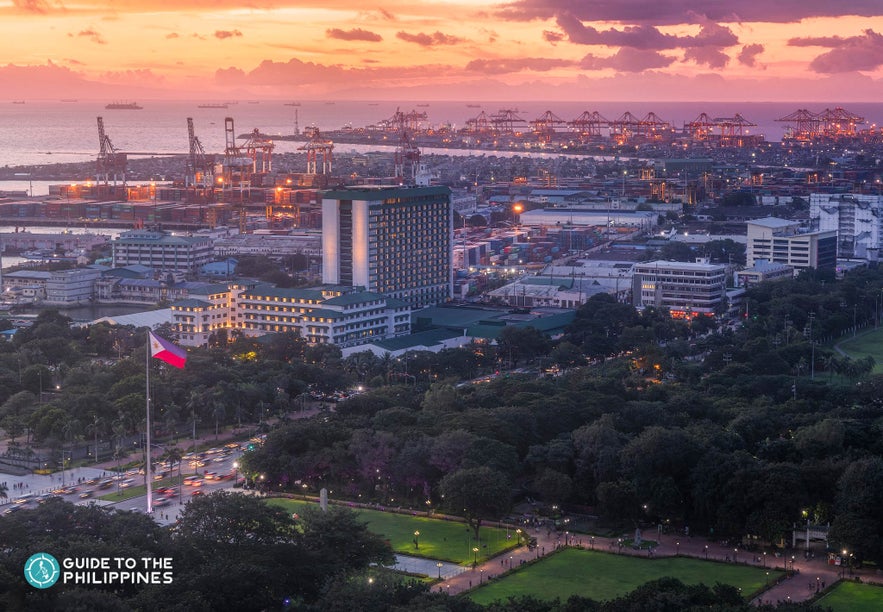
While it may not have the same lively appeal as Ermita, the Port Area district plays a vital role in the trade and finance landscape of Manila City. As home to the Philippine Ports Authority and one of the busiest ports in Southeast Asia, this area is a bustling hub for commerce and maritime activity.
Though the district lacks museums, trendy spots, or vibrant nightlife, its industrial and historical relevance remains significant. However, finding accommodations here can be challenging, as options are limited compared to other areas near Intramuros Old Town. Travelers seeking convenient and comfortable lodging are better off exploring nearby districts like Ermita, which offer a wider range of accommodations in Manila City.
If you want to skip the hassle of searching for the best places to stay, consider booking travel packages in Manila City. These vacation packages offer a hassle-free way to secure top-rated accommodations, handle all the planning for you, and ensure your lodging is conveniently located in the best areas.
Accommodation Highlights
Manila City stands as a vibrant tourism hub, offering a wide range of accommodations that ensure travelers experience the best of Filipino hospitality. From luxurious hotels near iconic landmarks to budget-friendly lodgings nestled within charming districts, accommodations here are designed to cater to all types of travelers.
What sets Manila City apart is its warmth and dedication to creating memorable stays. Many hotels feature modern amenities and convenient locations near attractions like Intramuros Old Town, Rizal Park, and shopping districts.
Budget Accommodation
If you're looking to save money for exciting activities around Intramuros Old Town and beyond, Manila City offers several budget-friendly accommodations without compromising convenience and comfort. Here are some great options both within and near the walled district:
White Knight Hotel Intramuros

Photo by White Knight Hotel Intramuros
Nestled inside the historic Plaza San Luis Complex, White Knight Hotel Intramuros offers affordable rates despite its prime location. This charming hotel also collaborates with Club Intramuros for a golf package, making it a great choice for golf enthusiasts. It doubles as a popular venue for weddings and birthday celebrations, thanks to its picturesque setting and excellent service.
Casa Bocobo Hotel
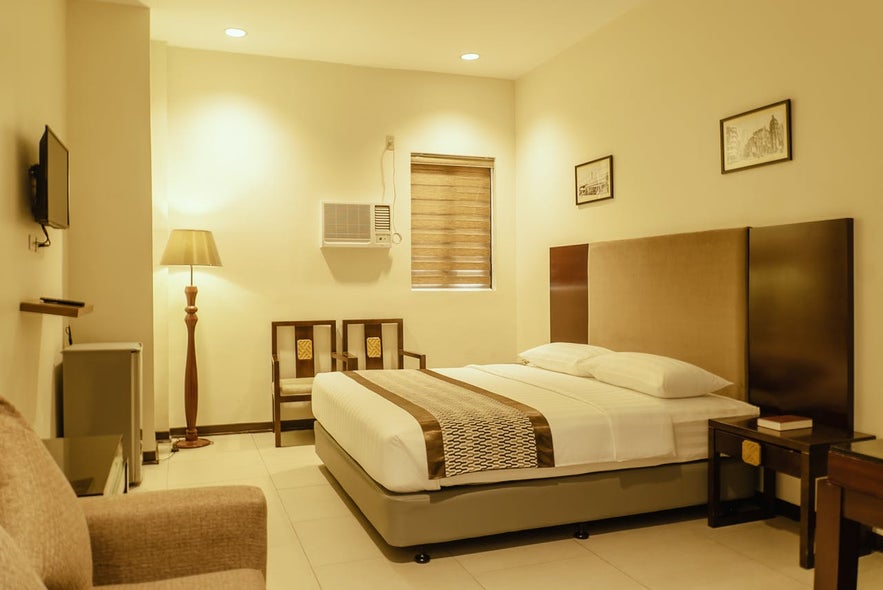
Photo by Casa Bocobo Hotel
For even more affordable accommodations, Casa Bocobo Hotel in Ermita District is a fantastic option. Situated on Jorge Bocobo Street, it offers essential amenities such as air-conditioned rooms, Wi-Fi, cable TV, orthopedic beds, and even a buffet breakfast—all at budget-friendly prices. Guests will also appreciate its convenient location, just a short walk from shopping malls, historic landmarks, and popular attractions in Manila City.
To make your stay even more seamless, consider booking travel packages in Manila City. These packages take care of accommodations, ensuring you stay in top-rated budget-friendly hotels conveniently located near key attractions, letting you focus on enjoying your trip stress-free.
Mid-Range Accommodation
If you're seeking accommodations that strike the perfect balance between comfort and value, these mid-range options in Manila City offer excellent services without breaking the bank.
Hotel H2O

Photo by Hotel H2O
Situated on the scenic waterfront next to Manila Ocean Park, Hotel H2O provides a unique stay experience with its aquatic-themed ambiance. Its convenient location places you just minutes away from Intramuros Old Town, making it an ideal choice for families, especially those traveling with children.
The hotel offers Wi-Fi access throughout its rooms and common areas, along with modern conveniences such as LCD TVs with cable channels, pillow-top beds, and 24-hour room service. Additional amenities, including in-room massages, hypoallergenic bedding, and ironing facilities, can be requested to ensure a comfortable stay. Guests can unwind at the café and lounge or enjoy drinks at the poolside bar.
Luneta Hotel

Photo by Luneta Hotel
Luneta Hotel stands as a historic landmark in Manila City, blending old-world charm with modern comforts. Although it features only 27 rooms, the hotel’s dedication to providing quality service makes it a standout option for travelers seeking a cozy yet memorable stay near Intramuros Old Town.
Guests can enjoy complimentary Wi-Fi in both rooms and public areas, LED TVs with premium channels, and well-stocked minibars. For those who prefer social spaces, the hotel offers a charming café and a bar/lounge, perfect for relaxing with drinks. The attentive staff can assist in arranging tours around Manila City, while the nightly turndown service ensures a touch of luxury to your stay.
Luxury Accommodation
For travelers who want to experience the finest in luxury, these high-end hotels in and around Intramuros Old Town provide exceptional service and lavish amenities for a truly unforgettable stay.
Bayleaf Hotel Intramuros
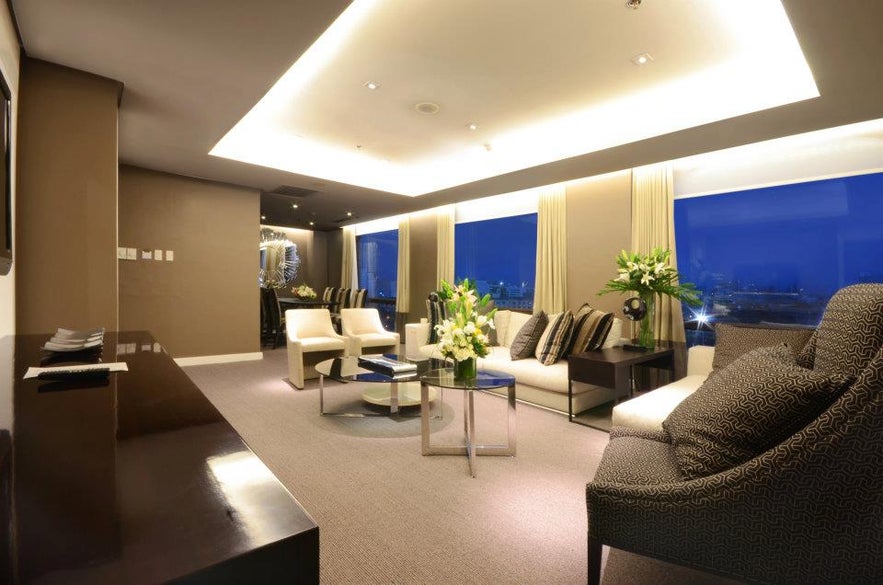
Photo by Bayleaf Hotel Intramuros
Located within the historic walls of Intramuros Old Town, Bayleaf Hotel is a boutique establishment managed by the Lyceum of the Philippines University, providing students with hands-on experience in the hospitality industry.
The hotel’s standout feature is its rooftop, home to the Sky Deck, which offers one of the best views of the Manila sunset. This trendy spot is perfect for relaxing and taking in the beauty of the city.
Each of the 57 rooms is thoughtfully designed with high-quality bedding, a mini-bar, a safety deposit box, a 32-inch LCD TV, and Wi-Fi, making it a comfortable and modern choice. Bayleaf is also a haven for food lovers, with several dining options, including Sky Deck, serving a variety of delectable dishes that make it an ideal stop for culinary enthusiasts.
Manila Hotel
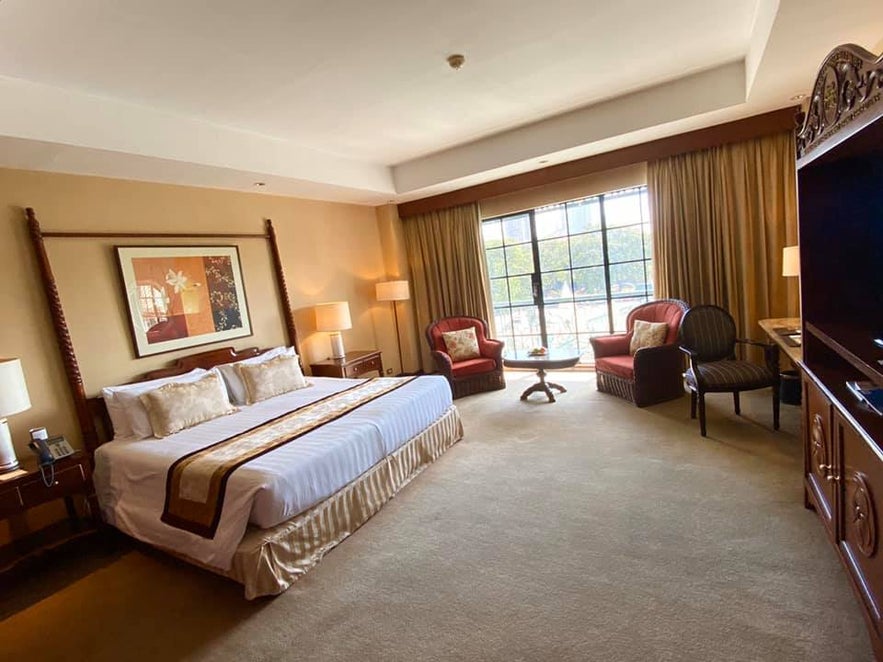
Photo by Manila Hotel
As one of the most iconic luxury hotels in the Philippines, Manila Hotel has long been a favorite of both Filipino elites and international dignitaries. The hotel’s opulent ambiance is immediately evident with the grand chandelier that graces the main lobby.
Each of its 515 rooms features luxury amenities like Wi-Fi, iPod docking stations, 42-inch TVs with premium cable channels, and deep-soaking bathtubs, offering the perfect way to unwind after a busy day in Manila City.
With six restaurants, including swim-up and poolside bars, you’ll never be short of dining options. Fitness enthusiasts will appreciate the hotel’s aerobics, yoga, and pilates classes, ensuring a balanced stay that caters to both relaxation and wellness
What to See and Do in Intramuros Old Town
Though Intramuros Old Town may be small compared to other tourist destinations in Manila City, every corner of this historic walled city is filled with fascinating stories and rich history, all within walking distance of one another.
Read on to uncover the must-try activities and best places to visit in Intramuros Old Town.
Marvel at the architecture of heritage churches

Given the significant role the Spaniards played in spreading Christianity throughout the Philippines, it makes sense that Intramuros Old Town is home to several churches where they could practice their faith.
The Minor Basilica of the Immaculate Conception, also known as Manila Cathedral, serves as the seat of the Roman Catholic Archdiocese of Manila, making it one of the most significant churches in the country. Since its establishment in 1581, the church has been renovated and restored several times, most notably after the 1945 Battle of Manila. The current structure follows the Neo-Romanesque style and was consecrated in 1958.
Speaking of resilience, San Agustin Church stands as a testament to history. Consecrated in 1607, it survived World War II and is said to be the oldest stone church in the Philippines. Miguel López de Legazpi, the first Spanish Governor-General of the Philippines, is buried near the church’s high altar.
San Agustin Church is a prime example of Spanish Baroque style, with its Trompe-l'œil ceilings and grand high altar. Its historical significance earned it a UNESCO World Heritage Site designation in 1993 under the Baroque Churches of the Philippines.
To fully immerse yourself in the rich history and stunning architecture of these heritage spots, consider booking a tour to the historic churches of Manila City. This guided tour takes you through the awe-inspiring Manila Cathedral, with its Neo-Romanesque design, and the timeless San Agustin Church, a masterpiece of Spanish Baroque. The convenience of a guided tour ensures you don’t miss any fascinating details while exploring these iconic landmarks in one seamless, enriching experience.
Take a closer look at the stone walls, gates, and forts
Video by the Philippine Department of Tourism
A visit to Intramuros Old Town wouldn’t be complete without marveling at its iconic stone walls, gates, and forts that once protected the Spanish colonizers and elite. These fortifications still stand strong today, surrounding much of the city, with a small stretch open near the Pasig River.
Fort Santiago, located at the northwestern edge of Intramuros Old Town, is arguably the most famous fort. Once the seat of Spanish military power, it held many prisoners, including the country’s national hero, Dr. Jose Rizal. Rizal spent his final days in the fort before his execution in 1896 at the nearby Luneta Park.
Today, Fort Santiago is home to the Rizal Shrine, a museum dedicated to the life and legacy of the Philippines' most celebrated hero. You’ll also find the iconic gate of St. James the Moor-slayer, the patron saint of Spain, that marks the entrance to the fort.
Intramuros Old Town is also home to several other forts, each with its own unique history. Don't miss Baluarte de San Diego, the oldest fort that once surrounded the fort of Nuestra Señora de Guia, or Puerta de Isabel II and Puerta de Santa Lucia. Other notable sites include Baluartillo de San Jose, Reducto de San Pedro, Puerta Real, Revellin de Real del Bagumbayan, Baluarte de San Andres, and Baluarte de San Gabriel.
With so much to explore, you can easily spend a full day immersing yourself in the history and beauty of Intramuros Old Town. Consider booking a travel package in Manila City to make the most of your visit, which can include a guided tour to help you navigate the historical sites and provide insight into the fascinating past of the city.
Pass time at the public squares and notable structures

Intramuros Old Town, once home to the select few, is dotted with public squares where you can relax and immerse yourself in its historical ambiance. Plaza de Roma, the most popular and historic of these squares, has long been a central gathering point.
Located near iconic landmarks like the Manila Cathedral, Palacio del Gobernador, and Ayuntamiento, Plaza Roma is considered the city's plaza mayor, or main square. In the past, it hosted public events such as bullfights. It was transformed into a garden in 1797, with a monument dedicated to King Carlos IV of Spain at its center. The king is remembered for sending smallpox vaccines to the Philippines.
While you're there, take the time to explore the Ayuntamiento, renowned for its neoclassical design. Formerly the seat of Manila's city council, its opulent interior earned it the nickname "Marble Palace." Sadly, the building was damaged by earthquakes and wars, leaving only parts of its first story intact. It has been rebuilt three times over the centuries and now houses the Bureau of Treasury office.
You can also visit other historic squares and buildings in Intramuros Old Town, including the Palacio del Gobernador, Plaza Moriones, Plaza México, Plaza Sto. Tomas, and Plazuela de Sta. Isabel, which is home to a memorial monument for the civilian victims of World War II. These sites offer a unique glimpse into the storied past of Manila City, so be sure to include them when planning where to go in Intramuros Old Town.
Learn more about Philippine history at these museums
While in Intramuros Old Town, dive deep into the fascinating history of the walled city and Manila City itself. Going on museum tours presents the perfect opportunity for history lovers to explore and learn more about the Philippines’ rich past.
San Agustín Museum
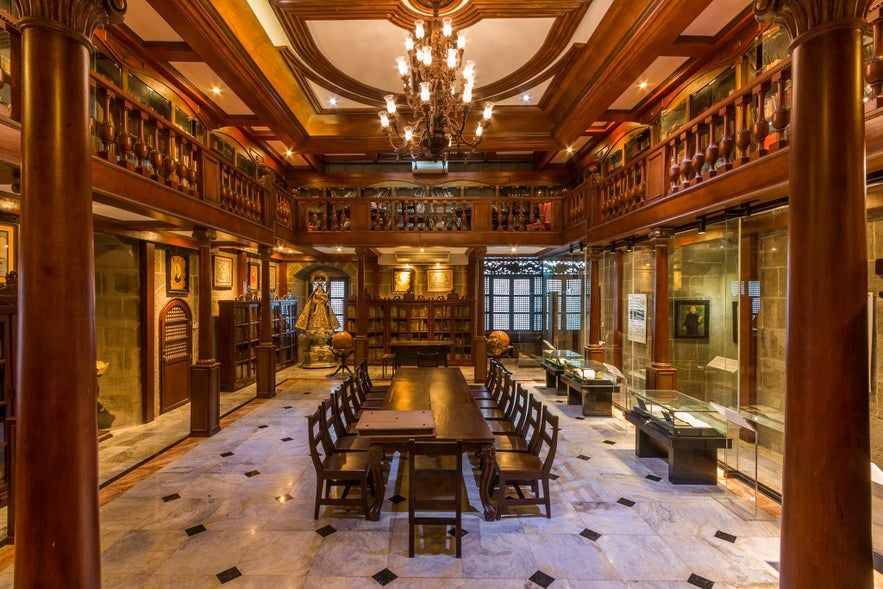
Photo by San Agustin Museum
Step into a treasure trove of Spanish colonial-era artifacts, including ecclesiastical garments, sacred vessels, manuscripts, and statues made of wood and ivory. The San Agustin Museum is home to an impressive collection that tells the story of the country’s religious and cultural heritage.
Light and Sound Museum
Take a journey through Philippine history in this interactive museum, where you can experience the Spanish colonial era and the life of national hero Dr. Jose Rizal through vivid images, sounds, and animatronics. It’s a fun and educational way to learn about the country’s past.
Bahay Tsinoy
Learn about the vital contributions of the Chinese-Filipino community to Philippine history, including their role in the revolution against the Spanish colonizers.
The museum also houses other galleries, such as the Bahay na Bato (Chinese settlement in Manila), Ching Ban Lee Ceramics Gallery, Martyrs Hall, and Batang Tiaong, offering a glimpse into the diverse culture of the Philippines.
Casa Manila
Video by the Philippine Department of Tourism
Explore a beautifully restored 18th-century home that recreates the lifestyle of the Ilustrados, the educated and affluent class during the Spanish colonial period. The house is filled with period furniture, artwork, and other artifacts that offer a window into the past.
These museums in Intramuros Old Town provide a rich, immersive experience in Philippine history. For a more in-depth visit, consider joining a tour to explore these cultural gems and gain fascinating insights into Manila City’s past.
Centro de Turismo Intramuros
Centro de Turismo Intramuros is a must-visit destination for history lovers and culture enthusiasts exploring Intramuros Old Town in Manila City. Housed in the beautifully restored San Ignacio Church, this interactive museum offers a deep dive into the walled city's rich history.
Visitors can explore Intramuros Old Town's cultural significance, from its Spanish colonial origins to its modern role in Manila City. With a range of historical artifacts, including religious icons and sculptures, and interactive QR codes providing educational videos, it’s a must-see for an immersive and informative experience.
What to Eat and Drink in Intramuros Old Town
When in Intramuros Old Town, dining is about more than just food—it's about the ambiance and cultural experience that each meal brings. While some establishments serve international dishes, the best way to immerse yourself in the flavors of Manila City is by savoring local favorites that showcase traditional Filipino cuisine and offer a taste of history.
Local Cuisine

Intramuros Old Town may not have the same variety of local cuisine as other provinces in the Philippines, but it still offers an exciting selection of Filipino and Spanish-inspired dishes. For a broader food adventure, consider exploring the nearby Binondo district—Manila City's vibrant Chinatown and the oldest Chinatown in the world. You can join a Binondo district food crawl to sample local favorites and dive deeper into the culinary delights of the area.
Within Intramuros, however, you can still enjoy a selection of restaurants that offer traditional Spanish and Filipino dishes, providing a truly immersive cultural experience.
Recommended Best Restaurants and Bars
Intramuros Old Town is a vibrant culinary destination, offering a delightful blend of traditional Filipino restaurants, colonial-era inspired dining spots, and casual eateries. Whether you're craving Filipino comfort food, international dishes, or a unique fusion of both, you'll find a range of food stops that cater to every taste and preference. Many of the establishments not only offer delicious meals but also provide a chance to experience the rich culture and history of Manila City. Here are some of the best places to try when you're in the area.
Barbara's Heritage Restaurant

Barbara’s, located within the historic Casa Manila, serves up a delightful mix of traditional Filipino and Spanish dishes, along with some European-inspired options. The restaurant’s buffet lunch caters to office-goers and visitors alike, offering a feast that transports guests through the flavors of the Philippines.
In addition to its delicious meals, Barbara's is known for its nightly cultural shows, called Kultura Night. Guests are treated to an evening of traditional Filipino dance performances by the Folklorico Filipino Dance Company, showcasing popular dances like the Singkil, Tinikling, and Pandango sa Ilaw. Buffet customers can enjoy this captivating 45-minute show for free, making it an unforgettable part of their Intramuros Old Town experience.
Ilustrado Restaurant

Photo by Ilustrado Restaurant
Opened in 1989, Ilustrado Restaurant has long been regarded as one of the best dining spots in Intramuros Old Town—and it's easy to see why.
Set in a beautifully restored Spanish-era house, Ilustrado captures the essence of Old Manila with its charming ambiance. The restaurant is renowned for its creative take on adobo, a dish considered by many as the national dish of the Philippines.

Photo by Ilustrado Restaurant
Ilustrado’s signature dishes include Adobong Bagnet and Prawns with Taba ng Talangka, where tender pork belly is simmered in a blend of six spices and crab fat sauce. This rich, flavorful dish carries a special warning on the menu: "Please Be Careful with My Heart."
For dessert, try the Sampaguita Ice Cream, made with the country's national flower, Sampaguita, with actual petals mixed in for a unique touch.
Beyond local specialties, diners can indulge in traditional Spanish dishes like Paella, along with options like Salmon, Duck, and Lamb Chops. Ilustrado is also conveniently located near Kuatro Kantos Bar, a coffee shop that’s perfect for art enthusiasts to unwind after a satisfying meal.
Ristorante Delle Mitre

Photo by the Philippine Department of Tourism
Owned by the Catholic Bishops’ Conference of the Philippines (CBCP), Ristorante Delle Mitre is located across from San Agustin Church in the CBCP building.
Named after the tall headdress worn by bishops and senior abbots, the restaurant serves dishes inspired by the favorites of priests and bishops across the country. Some dishes are even named after these clergymen, such as Father John Christian Young’s Sinigang na Crispy Pata, Father Beltran’s Tuna Belly with Mashed Potatoes, and Monsignor Dennis Villarojo’s Seafood Pasta with Marinara Sauce.
The menu features a delightful mix of Spanish, Italian, and Filipino dishes, with nuns often helping in the kitchen, adding to the special atmosphere of the restaurant.
9 Spoons
Located in The Bayleaf, 9 Spoons offers a chic, casual dining experience paired with panoramic views of the Manila City skyline and Intramuros Golf Course. While the views are spectacular, the real treat lies in their heritage Filipino dishes.
Don't miss the Bayleaf All Day Tapa and Kare-kare for a comforting taste of home. The menu also features international dishes such as wood-fired pizzas, pasta, and sandwiches.
Sky Deck

Photo by Bayleaf Hotel Intramuros
Another gem inside The Bayleaf, Sky Deck offers a stunning 360-degree view of Manila City. Located on the rooftop of the hotel, it’s the perfect spot to catch a mesmerizing Manila sunset.
Along with a breathtaking setting, Sky Deck serves a mouthwatering array of dishes, including the legendary Bayleaf Tapa with Garlic Rice and Eggs. Be sure to also try their pasta dishes and Filipino-style desserts like the Ensaymada Pudding, which features ensaymada with crème anglaise and mango balls.
Coco Bango Café
Located inside White Knight Hotel, Coco Bango Café is a local favorite known for its diverse menu, featuring Filipino, Italian, Japanese, Chinese, Spanish, and European-inspired dishes.
Patrons rave about the classic Beef ala Bulalo, especially on rainy days, and the Inihaw na Pusit, which makes for the perfect bar snack.
Practical Information and Tips
Planning your visit to Intramuros Old Town and exploring the rich history of Manila City requires some research to ensure a smooth and enjoyable experience. Here are a few practical tips to help you navigate the city and make the most of your time in this historic district.
Language
The national language, Filipino, is most commonly spoken in Manila City, but you'll also hear other Philippine dialects. However, foreign visitors need not worry, as a vast majority of Filipinos can speak and understand basic English. Most tour guides in Intramuros Old Town also offer services in English, making it easy for you to learn about the city's fascinating history.
Currency
Before traveling to the Philippines, make sure to check the current exchange rates for your foreign currency. You can easily exchange money for pesos (Php) at the airport, or you can find forex services in malls throughout Manila City. Major establishments also accept credit cards, but it's always advisable to have small bills in denominations of Php 20, 50, and 100 for transactions with vendors or when using public transportation.
Safety Tips
Filipinos are known for their friendliness and hospitality, but, as in any place, it's important to stay alert. Use smart judgment when interacting with people and keep an eye on your belongings to avoid petty crimes. The police and security guards are good resources if you need assistance. Additionally, always check the weather forecast before planning your activities to avoid unexpected weather disruptions.
Public Transportation Tips
Traffic congestion in Manila City is well-known, and while Intramuros Old Town is relatively easy to navigate, getting around Manila City may require more time. If you're traveling within the city, it's a good idea to allot at least an hour for land travel. If you're using public transportation, especially trains, be mindful that rush hour (7 AM to 9 AM and 5 PM to 9 PM) can be quite crowded. To avoid this, try traveling during off-peak hours when possible.
- Read the ultimate guide to the top modes of transportation in the Philippines
What to Pack
Be sure to pack your essentials such as your passport, identification, and money, but don't forget a smartphone with a pocket Wi-Fi or a local SIM card for data access. While many places in Manila City offer Wi-Fi, it’s not always available in public areas. For comfort, pack light clothing and comfortable walking shoes, as you'll likely be doing a lot of exploring. If rain is expected, bring an umbrella, jacket, or raincoat. On sunny days, be sure to pack a change of clothes, towels, and plenty of drinking water to stay hydrated.
Sample Itinerary in Intramuros Old Town

Intramuros Old Town is a treasure trove of historical landmarks and cultural experiences, making it an ideal destination for a half-day adventure in Manila City. In this itinerary, you’ll get to walk through the cobbled streets, visiting key sites like Fort Santiago, the Manila Cathedral, and Casa Manila.
Whether you're a history buff or a curious traveler, this itinerary offers a perfect mix of learning and scenic exploration.
Intramuros Old Town Half-Day Tour
-
8:30 AM – 9:00 AM: Arrival at Intramuros Old Town
-
9:00 AM – 9:45 AM: Fort Santiago
-
9:45 AM – 10:30 AM: Plaza Roma and the Cathedral of Manila
-
10:30 AM – 11:30 AM: Casa Manila and San Agustin Church
-
11:30 AM – 12:30 PM: Baluarte de San Diego
-
12:30 PM – 1:30 PM: End of the Tour and Optional Lunch
To make sure you experience all the must-visit spots and gain local insights, booking a guided walking tour of Intramuros Old Town is a great choice. A local guide will offer fascinating historical, architectural, and cultural insights, enhancing your understanding of the district’s heritage while exploring iconic landmarks.
Frequently Asked Questions About Intramuros Old Town
What is Intramuros?
Intramuros is a historic walled city in Manila built during the Spanish colonial period. It served as the center of government, religion, and education in the Philippines for centuries and is now a preserved heritage site.
What are the top tourist spots in Intramuros old town?
Key attractions include Fort Santiago, San Agustin Church, Manila Cathedral, Casa Manila Museum, and the Rizal Shrine. Visitors can also explore old city walls, gates, and Spanish colonial streets.
How do I get to Intramuros old town?
The old town of Intramuros is located in the heart of Manila City and is accessible by taxi, ride-hailing apps, jeepneys, or the LRT (Light Rail Transit) via the Central Terminal station. It's close to other landmarks like Rizal Park and Manila Bay.
How much time should I spend in Intramuros old town?
You can explore the main attractions in 3 to 4 hours, but a half or full day is ideal if you plan to take a guided tour, visit multiple museums, dine at local cafés, or attend cultural events.
Is Intramuros old town safe for tourists?
Yes, Intramuros old town is generally safe for visitors, especially during the day. Tourist police and security personnel are present, and most attractions are within walking distance of each other.
Can I join a guided tour of Intramuros old town?
Yes. You can book guided walking tours, bamboo bike tours, and Manila City tours that include Intramuros through Guide to the Philippines for a more engaging and informative experience.
What should I wear when visiting Intramuros?
Wear light, comfortable clothing and walking shoes, especially if you're visiting during the day. If you plan to enter churches like San Agustin or Manila Cathedral, modest attire is recommended.
Can cruise passengers join Intramuros tours during a Manila stopover?
Yes. Cruise passengers can enjoy half-day or short tours from Manila City cruise port to Intramuros, which is only a short drive from the pier. These Intramuros tours from Manila cruise port can be booked independently through Guide to the Philippines, offering flexible, guided options that highlight the area’s rich history. These are ideal for travelers seeking things to do in Intramuros for cruise passengers or looking for independent tours to Intramuros without going through the cruise line.
Explore the Walled City of Intramuros

Intramuros Old Town is a captivating destination where history, culture, and modern Manila City meet. Whether you're exploring its historic landmarks, enjoying delicious Filipino cuisine, or immersing yourself in the local atmosphere, there's something for everyone. Don’t forget to make the most of your visit by planning your day thoughtfully, and be sure to explore the surrounding areas of Manila City. Save or share this Intramuros travel guide, and be sure to check out other exciting tours across the Philippines for your next adventure!




